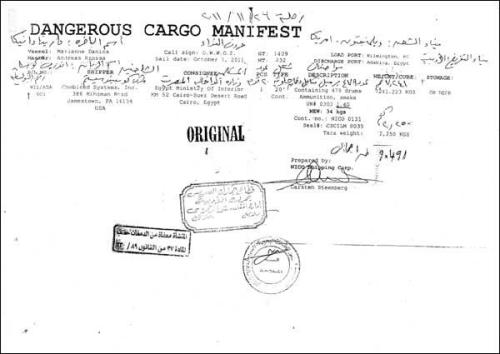Earlier last week, Egyptians poured out onto the streets across Egypt to protest President Morsi’s dictatorial decree overriding the power of the courts, attempting to keep a heavily Muslim Brotherhood-influenced constitutional assembly in tact, and granting himself seemingly unchecked authority over the nation. This past Friday, pro-democracy protestors poured into Egypt’s streets and pack its many squares again to counter Morsi and his attempts to quickly push through a controversial constitution in spite of popular outcry over his seizure of ultimate control over the Egyptian government.
U.S.-made tear gas has continued to rain down on protesters in Egypt calling for Morsi to reverse his decision as well as on those who filled Mohamed Mahmoud Street to call for justice and accountability for those who were gassed, beaten and murdered there exactly one year ago. Much of the tear gas — then and now — was made in Jamestown, Pa., by Combined Systems Incorporated, the same manufacturer whose seven-ton shipment, approved by U.S. government, was refused on November 27, 2011 by Asma Mohammed and her fellow customs workers at the Port of Adabiya in Suez.
The War Resisters League has awarded Asma Mohammed its 2012 Peace Award, given in the past to activists including Bayard Rustin, Bob Moses and Jeanette Rankin. Dr. Martin Luther King Jr. spoke at the first WRL Peace Award event in 1958.
Mohammed’s refusal of the tear gas shipment from the Port of Wilmington, N.C., came following the unprecedented deployment of thick walls of tear gas against protesters near Tahrir Square during the “battle of Mohamed Mahmoud.” The “battle” on this street near Tahrir, began on Friday, November 18, 2011 and lasted for eight days. During this time, Egyptian riot police killed tens of young men, most of them poor and working class—some estimates of the death toll are as high as 50. Hundreds of thousands of people remained in the square during this time, and volunteers at the makeshift field hospitals in Tahrir for the injured noted that some of the bodies that returned were completely black from the gas, as if they had been burned.
In addition, though Tahrir was a relatively “safe” place during the attacks on people at Mohamed Mahmoud, a new kind of chemical agent was used against people in the square on at least one day in particular. On the spent canisters, protesters read the term “CR,” different from the “CS” gas they normally saw. CR gas was said to cause violent convulsions, unconsciousness, and seizures—something they had never before experienced. It was enough to spark a new macabre and biting chant among the revolutionaries: “asha’ab yureed al-ghaz al-adeem!” (“The people want the return of the old gas!”)
Asma Mohammed, whose act of resistance to tear gas and to US support for the regime led to the formation of the General Independent Union of Port Workers, recalls: “I said ‘No, I refuse — because I don’t want to be the cause of someone’s pain or death.’ So in solidarity with me, or with the cause, my co-workers said ‘No, we’re not going to work on it either.’”
Asma Mohammed and her counterparts in the independent Egyptian labor movement, a key force in the unfolding revolution, have been present in the streets of Egypt over this past week. The protests continue while the tear gas, beatings and repression remain the norm under Morsi’s civilian government, as it was under the Supreme Council of Armed Forces’ military junta. On Tuesday, the Egyptian “Popular Alliance Party” member Fathy Ghareeb died of asphyxiation as a result of tear gas fired in Tahrir Square.
As Morsi tries to justify his takeover with the promise for justice for those killed by government forces on streets including Mohammed Mahmoud, Asma Mohammed recognizes that only the people of Egypt can protect the revolution and calls on the people of the U.S. to join her: “The Arab people now want to be the decision makers. Just as the American people should be the decision makers and affect their government in the decisions it makes. We also want our rulers to know that we are the ones that are going to influence things. And they’re not going to understand that until governments of the world begin to act according to that logic.”
And as the US embassy in Cairo tweeted last Tuesday, “The Egyptian people made clear in the January 25th revolution that they have had enough of dictatorship” while the US continues to send tear gas and military aid to the Egyptian government, the ordinary people of the US must recognize that we are the only ones here who are of any use to the revolution.
For more information about US-made tear gas in Egypt, go to: facingteargas.tumblr.com.





imagine no countries….. nothing to kill or die for -John Lennon